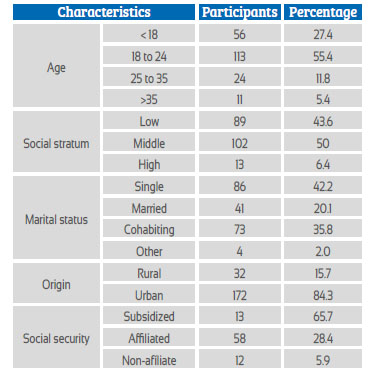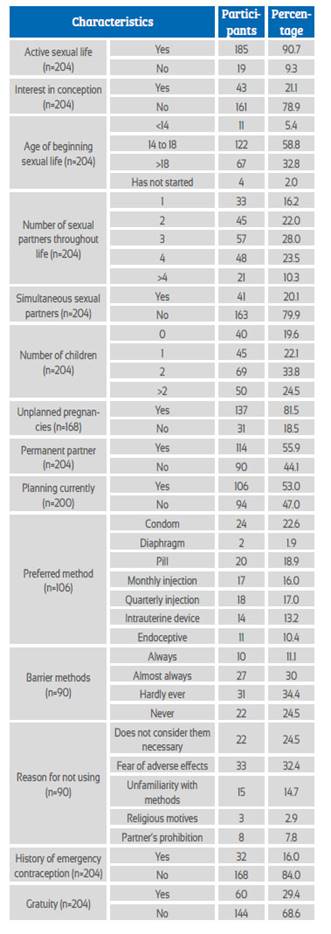Services on Demand
Journal
Article
Indicators
-
 Cited by SciELO
Cited by SciELO
Related links
-
 Similars in
SciELO
Similars in
SciELO
Share
Revista Peruana de Ginecología y Obstetricia
On-line version ISSN 2304-5132
Rev. peru. ginecol. obstet. vol.66 no.3 Lima Jul-Sep 2020
http://dx.doi.org/10.31403/rpgo.v66i2260
Original Articles
Contraceptive practices in women of an educational institution in the City of Popayán, Colombia
1Universidad del Cauca, Popayán, Colombia
2Universidad CES, Medellín, Colombia
3Universidad Cooperativa de Colombia, Pasto, Colombia
4Universidad Pontificia Javeriana. Bogotá-Colombia
Introduction: At least 200 million women worldwide do not have access to family planning services despite the fact that conditions related to pregnancy, childbirth and the puerperium constitute one third of morbidity and mortality in women of reproductive age. Objective: To determine contraceptive practices in women of an educational institution in the city of Popayán, Colombia. Methods: A crosssectional study was conducted in 204 women, to whom a structured questionnaire was applied according to the variables measured. Results: Approximately 90% of the participants reported active sex life, 59% had a sTable partner and 53% were currently family planning, while 21% mentioned having interest in conceiving. The most common family planning method was the condom, followed by oral contraceptives and injecTable hormones. Conclusions: In the population studied, receptivity to contraceptive methods was limited. In contrast to the available literature, these practices were influenced by the sociodemographic characteristics of each population, being different among sociocultural contexts.
Key words: Family planning; Contraception; Contraceptive agents
Introduction
Each year, approximately 80 million women worldwide have unwanted or unplanned pregnancies, 60% of which end up in abortions. 97% of these occur in developing countries and they result in 68 000 deaths annually1. It is estimated that until the beginning of last decade, the number of women who had unfulfilled necessities concerning conventional contraceptive methods was above 222 million. According to calculations, the use of contraceptive methods in low income countries could prevent 218 million unwanted pregnancies and 55 million unplanned childbirths per year2.
On the other hand, the use of contraceptives diminishes maternal mortality and improves women's health by preventing unwanted pregnancies, reducing the need for abortions performed under non-aseptic conditions(3.4). In addition, the misuse of contraceptives is directly related to increased rates of method error5-7.
The number of unwanted/unplanned pregnancies can be reduced by more than 50% by implementing family planning programs8. This becomes more worrisome when considering the documented contraceptive use prevalence of about 4-12% in many developing countries(1.5). At least 200 million women worldwide are estimated not to have access to family planning services, even though conditions related to pregnancy, childbirth and the postpartum period account for one third of morbidity and mortality in women of reproductive age (15-44 years)1).
The objective of the following study is to describe the practices of family planning by women in an educative institution in the city of Popayán, Colombia.
Methods
A descriptive, cross-sectional study of women enrolled in labor education programs of the Forensic Institute of the City of Popayán was carried out in the second half of 2019. Women over 18 years of age who were willing to participate voluntarily were included in the study, excluding those who did not wish to participate and women with definitive planning methods (salpingectomy). The study was approved by the institution's directors, as it met the ethical requirements necessary for its implementation. A questionnaire was developed, with consecutive internal serial to allow its operationalization, in order to avoid the need to record any identification data by the students to whom it was addressed. The questionnaire was completed once direct informed consent was obtained from each participant. In this study. Data under investigation was recorded in two sections: one aimed at determining the socio-demographic characteristics and the other at establishing the family planning practices of the population studied. The statistical analysis was carried out with the Microsoft Excel 2016 for Windows program. The quantitative variables are presented as percentages.
Results
A total of 204 women were surveyed. The characterization of the population is described in Table 1.
The present study found an average age of 21 years (SD 4.6), belonging especially to the lower and middle strata of the urban area of the city, most of which were affiliated to the social security system in Colombia. The sociodemographic variables varied according to the population in which the study was conducted.
Approximately 90% of the participants reported an active sex life, 59% had a steady partner and 53% were currently planning, while 21% mentioned an interest in conception. The most common method of planning was the condom, followed by oral contraceptives and injecTable hormonal methods. The rhythm method was not considered a planning method because of its high probability of failure. Among women who did not plan, the barrier method was used almost always by 30% and rarely by 34.4% of participants. The main reasons for not planning were fear of adverse effects (33%) and not considering it necessary. Sixteen percent of the women reported having used emergency contraception at some time, while 81 percent of the women who reported having children mentioned those were unplanned pregnancies. Only 29% were aware of free planning services. Of the women who reported having children, 81% mentioned having experienced unplanned pregnancies. Table 2 compiles the main results obtained in the study.
Discussion
The present study of contraception found an average age of 21 years (SD 4.6), a parameter that varies between the different studies depending on the populations studied. Nearly 90% of the participants had an active sexual life, a value higher than that found by Franco et al4 in Medellín. This difference is probably justified by the epidemiological characteristics of the two populations, the one in the present study being composed of younger women.
Among the women who did not plan, the main reasons for not doing so were fear of adverse effects (33%) and not considering planning necessary (27%). In this same group, 34.4% reported 'rarely' using barrier methods (condoms) for the prevention of sexually transmitted infections, while 24.5 reported never using them. In addition, 5.4% of the participants began their sexual life before age 14, while 63.9% did so before coming of age (18 years). Also, about 20% of the women responded positively to the presence of multiple sexual partners. These results could be explained by the average age of the population studied (21 ± 4.6 years). Early initiation of sex has been linked to the non-use of family planning methods, as well as to the occurrence of unplanned pregnancies. In Colombia, with respect to the use of family planning methods among the adolescent population, previous reports have found that this is heterogeneous among regions, with the Pacific region (to which the city of Popayán, capital of the department of Cauca, belongs) being the region where adolescents use contraceptive methods the least (44%)9).
On the other hand, 47% of the women in the present study did not plan at the time of the interview, an intermediate figure between those found in other studies in Medellín (38.7%) and in Spain (51.8%)4,10). In addition, 81% of the women with children reported having experienced unplanned pregnancies, a much higher figure than that reported in other locations (30%)4, but similar to that found by Moreno et al (70%), also in the city of Popayán11.
Similarly, in the present study, interest in conception was absent in approximately 79% of the women surveyed, a figure also intermediate between those reported by two similar studies (93% and 63%)4,12. The most used planning method was the condom (22.6%), with a lower percentage than reported by another study (47.6%)12. In addition to the average age of the participants, the results of both variables could be related to the fact that 44% of the participants reported not having a sTable partner.
In relation to family planning and women's educational level, many studies have documented a positive relationship between women's educational level and their knowledge of contraceptive methods9. The present study did not inquire into schooling because access to education for work in Colombia requires having completed at least basic secondary education, knowing in advance that the baccalaureate was the highest level of schooling achieved in the population studied.
Although this research did not measure this relationship, other studies have found no relationship between the level of knowledge about contraception and its use 4. In fact, in Colombia, it is estimated that there is widespread knowledge of contraceptive methods, so that 99.8% of women are aware of at least one method of planning12.
In conclusion, in the population studied, receptivity to family planning methods was limited. Family planning practices are influenced by the socio-demographic characteristics of each population, being different in the various sociocultural contexts. In the present study, the age of the participants was the main determinant of the results obtained.
REFERENCES
1. Fernández R, López L, Martínez H, Kopecky D, Uzcátegui G, Muñoz M. Anticoncepción de emergencia: percepción y conocimiento en nuevas usuarias del Servicio de Planificación Familiar. Rev Obstet Ginecol Venez. 2008;68(3):181-6. [ Links ]
2. Villalobos A, de Castro F, Rojas R, Allen B. Anticoncepción en adolescentes mexicanos de escuelas del nivel medio superior: uso y necesidades insatisfechas. Salud pública Méx. 2017;59(5):566-76. Doi.org/10.21149/8481 [ Links ]
3. Távara L, Cárdenas B, Becerra C, Calderón G, Panta D, Esteban I, et al. La planificación familiar requiere atención especial como estrategia para reducir la mortalidad materna. Rev peru ginecol obstet. 2011;57(3):177-87. [ Links ]
4. Franco L, Mora G, Mosquera A, Calvo V. Planificación familiar en mujeres en condiciones de vulnerabilidad social. Salud UIS. 2011;43(3):241-8. [ Links ]
5. Felix C, Frota P, Roemro R, Gomes C, Ferreira E, De Oliveira M. El conocimiento de las usuarias sobre el método de anticonceptivos orales de dosis bajas combinados. Rev Latino-Am Enfermagem. 2013;21(4):1-7. [ Links ]
6. Bahamondes L, Pinho F, Melo NR, Oliveira E, Bahamondes MV. Associated factors with discontinuation use of combined oral contraceptives. Rev Bras Ginecol Obstet. 2011;33(6):303-9. [ Links ]
7. Peláez J. El uso de métodos anticonceptivos en la adolescencia. Rev Cubana Obstet Ginecol. 2016;42(1):1-17. [ Links ]
8. Langer A. El embarazo no deseado: impacto sobre la salud y la sociedad en América Latina y el Caribe. Rev Panam Salud Publica/Pan Am J Public Health. 2002;11(3):192-205. [ Links ]
9. Torres M, González P. Antecedentes teóricos y empíricos del uso de métodos de planificación familiar. Rev Fac Cienc Econ. 2009;17(2):171-82. [ Links ]
10. Maroto A, Moreno A, Rubio M, Ortiz C, Escobar F. Conocimiento y uso de métodos anticonceptivos por la población femenina de una zona de salud. Rev Esp Salud Publica. 1998;72(6):547-57. [ Links ]
11. Moreno E, Ortiz R. Nivel de conocimiento respecto a la planificación familiar en gestantes que acudieron al Hospital Universitario San José, Popayán, Colombia, 2014-2015. Rev Colomb Obstet Ginecol. 2016;67(3):207-14. Doi.org/18.597/rcog.768 [ Links ]
12. Vieira I, dos Santos M, Holanda G, Gimeniz M. Aspectos reproductivos y conocimiento sobre planificación familiar de mujeres con síndrome de inmunodeficiencia adquirida. Rev esc enferm USP. 2017;51:1-8. Doi.org/10.1590/s1980-220x2016039403224 [ Links ]
6Cite as: MartínezMezaYE,SolanoLatorre LC, Banguera Riascos H, Joaquí Samboní WG, Díaz Ordoñez JC, Garzón Portilla MC, Peña Desmoineaux M. Family planning in women of an educational institution in the City of Popayán, Colombia. Rev Peru Ginecol Obstet. 2020;66(3). DOI: https://doi.org/10.31403/rpgo.v66i2260
Received: March 24, 2020; Accepted: April 25, 2020











 text in
text in 




